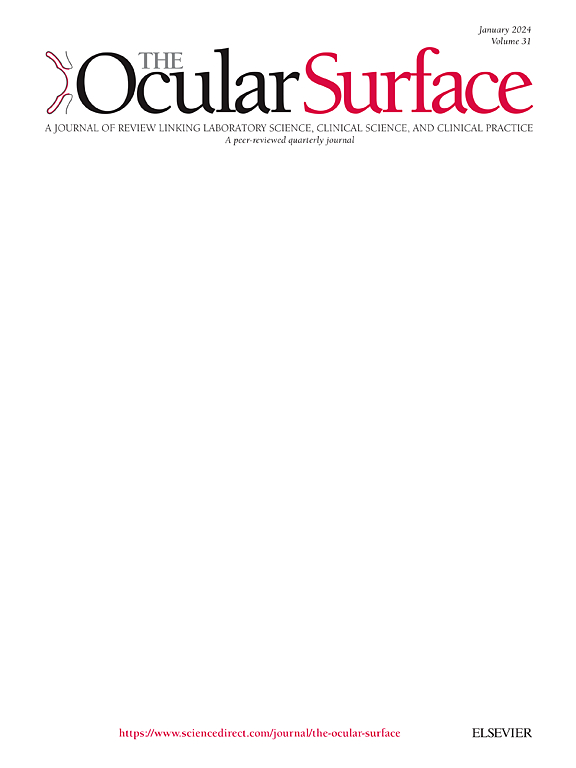Two models of the structures of the lamellae in human meibum and the tear film lipid layer, TFLL
IF 5.6
1区 医学
Q1 OPHTHALMOLOGY
引用次数: 0
Abstract
Two models of meibum and the TFLL are proposed. The first model is based on a reanalysis of x-ray studies which show the predominance of 11 nm thick lamellae above 30 °C, but below 30 °C, 5 nm thick lamellae predominate. By analogy to skin lipid, we denote these the long (LPP) and short period phase (SPP), respectively. In the model, the SPP lamellae are interdigitated bilayers of cholesteryl esters (CEs) oriented towards one surface and wax esters (WEs) oriented towards the other surface, with the long interdigitated CE and WE chains tilted. These lamellae are stacked with the same polarity, e.g., CE surface uppermost. At ocular surface temperature, the polarity of alternate layers is reversed, forming the LPP. This doubles the periodicity, but the tilt of the LPP long chains is reduced to render the periodicity more than twice the SPP. The model is consistent with changes in meibum near 30 °C found in calorimetry, viscoelasticity, infrared spectra, birefringence, reflectance, and high resolution images of meibum spread on saline. A secondary model explains the finding that most long saturated chains in CEs and WEs are branched. We propose a ‘bump and hollow’ model where a ‘bump’ is a branch on a WE chain fitting into a ‘hollow’, the linking oxygen atom in a neighboring CE chain; likewise, a bump on a CE chain fits a hollow on a WE chain. We aim to stimulate further development of lipid layer models, including the role of other molecules, to aid understanding of dry eye disease (DED).
人体膜层和泪膜脂层的两种结构模型。
提出了两种模型,分别是meibum模型和tfl模型。第一个模型是基于x射线研究的再分析,该研究表明,在30℃以上,11 nm厚的片层占主导地位,但在30℃以下,5 nm厚的片层占主导地位。与皮肤脂质类似,我们将它们分别称为长周期(LPP)和短周期(SPP)。在该模型中,SPP片层是面向一个表面的胆甾醇酯(CEs)和面向另一个表面的蜡酯(WEs)的交错双分子层,长交错的CE和WE链倾斜。这些片层以相同的极性堆叠,例如CE表面最上层。在眼表温度下,交替层的极性颠倒,形成LPP。该模型与热量法、粘弹性、红外光谱、双折射、反射率和高分辨率盐水中mebum分布的图像中发现的30℃附近mebum的变化一致。第二个模型解释了ce和WEs中大多数长饱和链是分支的这一发现。我们提出了一个“凹凸和空心”模型,其中“凹凸”是We链上的一个分支,与相邻CE链上的连接氧原子“空心”相吻合;同样,CE链上的凸起与WE链上的空洞相吻合。我们的目标是刺激脂质层模型的进一步发展,包括其他分子的作用,以帮助理解干眼病(DED)。
本文章由计算机程序翻译,如有差异,请以英文原文为准。
求助全文
约1分钟内获得全文
求助全文
来源期刊

Ocular Surface
医学-眼科学
CiteScore
11.60
自引率
14.10%
发文量
97
审稿时长
39 days
期刊介绍:
The Ocular Surface, a quarterly, a peer-reviewed journal, is an authoritative resource that integrates and interprets major findings in diverse fields related to the ocular surface, including ophthalmology, optometry, genetics, molecular biology, pharmacology, immunology, infectious disease, and epidemiology. Its critical review articles cover the most current knowledge on medical and surgical management of ocular surface pathology, new understandings of ocular surface physiology, the meaning of recent discoveries on how the ocular surface responds to injury and disease, and updates on drug and device development. The journal also publishes select original research reports and articles describing cutting-edge techniques and technology in the field.
Benefits to authors
We also provide many author benefits, such as free PDFs, a liberal copyright policy, special discounts on Elsevier publications and much more. Please click here for more information on our author services.
Please see our Guide for Authors for information on article submission. If you require any further information or help, please visit our Support Center
 求助内容:
求助内容: 应助结果提醒方式:
应助结果提醒方式:


